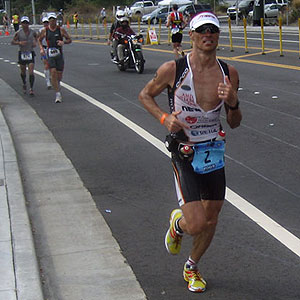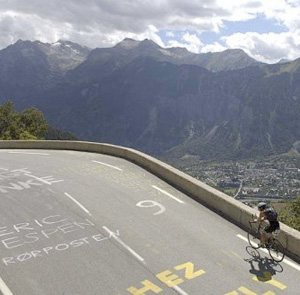Will Chrissie go 8:35 at Roth?
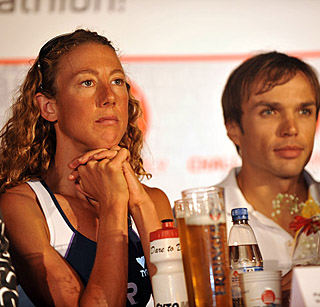
Thomas Hellriegel was at Roth 13 years ago when Lothar Leder first broke the 8-hour barrier. Hell on Wheels was also there the next year when Roth cemented its reputation as the fastest Iron-distance track on earth as Luc Van Lierde set a still-standing world best Iron-distance time of 7:50:27. Hellriegel too broke the 8-hour barrier that day in 1997 – but finished fourth.
As a sudden squall battered the Castle Ratibor with sheets of cool rain worthy of a Calcutta monsoon, Hellriegel was asked if the 2009 crop of men might have a crack at Van Lierde's 12-year-old mark?
"Last year here it was freezing rain and it was just not good conditions to go fast," said Hellriegel, alluding to Patrick Vernay's men's winning time of 8:09:34. "This year at Frankfurt, Timo Bracht went fast (7:58) because it was warm. That's what we need to have a fast race."
The difference between men and women
One journo asked: So why did the women break their world record here when, as you say, the conditions were not good for the men?
What followed was a disquisition on the physiological differences between men and women that started scientifically, but eventually broke up the house in laughter.
"I think the big factor is that women have less water in the body, so they struggle in the heat, as in Hawaii," said Hellriegel in his dry, Terminator-style delivery. "They don't have so much liquid, so they often drink more and have stomach problems. "
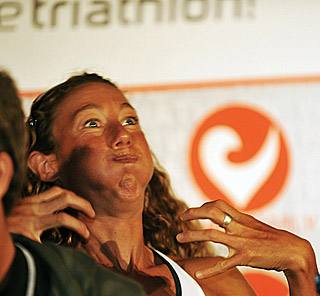
Then a perfect comedian's pause as Hellriegel explained why women go better in the cold.
"Also they have more fat!"
Immediately, a top roster of women that included Erika Csomor, Gina Ferguson, Belinda Granger, and Catriona Morrison roared with laughter. Two-time Ironman Hawaii World Champion Chrissie Wellington comically mugged like Lucille Ball, pumping up her ropy arm muscle, then bloating up her face like a grotesque fatty.
"Yes, but it's natural that women carry a lot more fat," continued Hellriegel. "And that is why they do not struggle so much in the cold." Whereupon Belinda Granger, the 2005 Quelle Challenge Roth champion, burst out good naturedly, "Women are tougher!"
Granger did admit that Hellriegel's assertion, backed by scientific evidence that elite men endurance athletes top out at 4-5% body fat while top women endurance athletes face systemic dysfunction at anything less than 8-9% body fat, was observably true. "Last year was a great year for the girls, because we do retain the heat," said Granger. "I was riding alongside some pro men and they looked like they were dying. Oh my gosh! I felt bad, but they looked five times worse. They'd turned purple!"
Indeed, the Netherland's Yvonne Van Vlerken nailed a 8:45:48 mark in that same cold rain last year, just 1:12 in front of returning contender Erika Csomor of Hungary. Van Vlerken trailed men's winner Vernay by just 36 minutes, one of the closest ever gender differences at the Iron-distance.
And so Hellriegel won the fair sex in the crowd over with his next observations. "But also, 10-15 years ago fewer women trained as professionals as the men," he said. "Maybe Paula Newby-Fraser, Natascha Badmann and a few others. But other than them, the average difference between the top men and women in an Ironman was one hour (11,5 to 12.5% ). This was a little bit too much – in the other sports like swimming and running, the difference is smaller (9- 10%). So now many women train as professionally as men, so the difference between men and women will be smaller – as it should be."
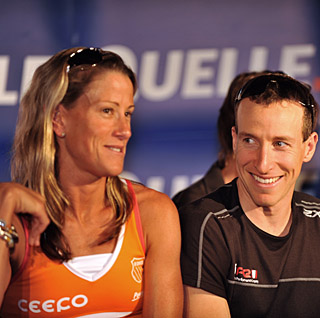
World record fever
Which brings matters to the current record-breaking point.
Paula Newby-Fraser's 8:50:53 world best mark set at Roth in 1994 lasted 14 years. With the number and quality of the women's fields reached a tipping point, last year the floodgates opened. Sandra Wallenhorst broke first at Ironman Austria on a similarly cold day with a sub-8:50 clocking. On a tougher course at Frankfurt, Chrissie Wellington smashed that race record with an 8:51. At Roth, Van Vlerken (8:45:48), Csomor (8:47:05), Gina Ferguson (8:57:18) and Belinda Granger (8:58:08) stormed past the once-formidable barrier.
This year, Wellington and Van Vlerken switched venues, as the Dutchwoman took on the World Triathlon Corporation's Ironman venue in Frankfurt, and the new Queen of Kona took on historic Roth. By the numbers, Wellington is primed to make an historic breakthrough – if the weather cooperates.
At Frankfurt, Sandra Wallenhorst of Germany won the duel, breaking the tape seven minutes slower than Wellington's 2008 mark. Van Vlerken, according to some reports suffering and off her game, took second in 9:03 – 12 minutes slower than Wellington's 2008 pace.
This year at Roth, Wellington says "I would like to break the world record, but most of all I want to win."
Top competitor Rebekah Keat of Australia, the same Rebekah Keat who lent Wellington her CO2 canisters at Kona to rescue Wellington from a flat and a DFN that would have denied her victory, flatly stated that Wellington is perfectly capable of shattering the women's record. "I believe she can finish Roth in 8:35," said Keat. "That's a 50 minute swim, a 4:50 bike and a 2:55 run."
The women rate Chrissie's, and their own, record chances

Chrissie's other competitors admit that this theoretical prediction is possible, perhaps plausible — if not probable.
Belinda Granger, 11-time Iron-distance winner, 2005 Quelle Challenge Roth champion: "It all comes down to the weather. If it's windy, it won’t happen. I think Chrissie can swim faster than Van Vlerken's 53:47. I think she is capable of running faster than Yvonne's 2:54:22. But Chrissie's biggest challenge will be the bike. It's not that I don't think she's a better bike rider. She is the best women's Ironman distance bike rider in the world. But it's her lack of experience on this course. You can lose so much time here. We go through 20 villages, and you have to know which corners you can pedal through and which ones you have to slow down in. Last year, Yvonne did well because she followed me and did what I did. What suits Chrissie here is the each short sharp hill is followed by a long, gradual downhill where she can get in a big gear and just grind."
Rebekah Keat: "It's doable for Chrissie. I hope to God she doesn’t for all of our sakes. At Port MacQuairie, Chrissie gave me a present of 300 CO2 canisters and she told me if she saw I had a flat, she'd stop to help. I hope it never comes to that. She's always friendly and nice and it's impossible not to like her."
Leanda Cave, 2002 ITU Olympic distance World Champion, two-time Escape From Alcatraz winner, Ironman Florida 70.3 winner, 7th at Roth last year (broken rib): "You know, she's had good races this year wins at Ironman Australia and Ironman Kansas 70.30) and some real bad (6th at Columbia Maryland Olympic distance triathlon). I think she's no machine. I don’t think you can pout down on paper a time like 8:35 and just expect it. Will she be able to go at a half Ironman pace (4:17:30) all day? She might. I think the world record (8:45) will probably come down, but I will be surprised if she hits 8:35."
Erika Csomor: "It's (8:35) possible. To ride 4:50 is not too hard for (Chrissie ). Even I can ride it. If she is challenged, it will help. After last year, (Csomor finished 2nd in 8:47:05) my expectations are higher. That can cause problems because your body might not survive what your mind asks it. That's my problem now. In my head I am the winner. While I am improving, so is everyone else."
Catriona Morrison, two silver medals at ITU long distance duathlon Worlds, 4th and 5th at Ironman 70.3 Worlds, in her first Iron-distance event: "I hope it's cold and rains like last year. It will feel like I'm back home in Scotland. I love the races with great competition, so I'm optimistic. (Did not comment on Wellington's record chances)
Normann Stadler when asked if Wellington can hit Rebekah Keat's prediction said: "That is amazing fast. I don’t know how fast a woman can go here. But she is fast and getting faster I think. She changed coaches (from Brett Sutton to Simon Lessing) and she is training fewer miles now and is getting better. She looks good. She looks strong. But to go 8:35, she can't stop for the toilet!"
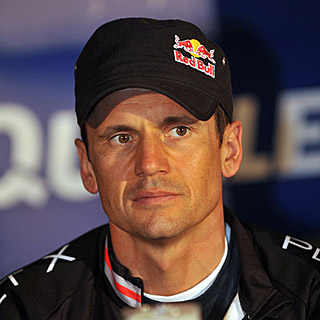
The men
Normann Stadler comes to Roth after a decade absence, with one race at Rloth on his resume — which he claims to forget. The two-time Ironman Hawaii champion comes to 2009 after two Kona disappointments (DNF gastro troubles in 2007, 12th in 2008 when he encountered stomach troubles after leading) and a light race load. Coming off an impressive 3:45 at a half Ironman distance race in Germany, including a 1:14 run in which he slacked off from a 1:10 pace when his lead reached 9 minutes, Stadler comes in humble, confident but not desperate.
In response to a question about Luc Van Lierde's 7:50:27: "Of course I'd like to set a world record, but I am definitely here to win the race. I do not think the world record is realistic for me. While it is possible, it is not realistic at this stage."
"I am planning for a fast pace and do not want to let the fast swimmers get too far away. I'll try hard to have a strong bike, but I also do not think the record bike split (Jurgen Zack, 4:14:16 in 1999) is likely. The days they rode the 4:14, for years they yelled "We have to catch the media vans, otherwise we are dropped. Conditions are not like that any more."
Yes, but can he beat Patrick Vernay, multiple Ironman Australia winner, winner at Roth last year? "This year we have fantastic athletes like Patrick, Pete Jacobs and Chris McDonald. But if I am in good form, it will be difficult for others to beat me."
Vernay, the New Caledonian phys ed teacher, was quiet and humble. "Last year because of the weather, I did not expect to win. But it was a good day for me. I can only hope I am stronger this year. This field is great, Normann Stadler especially. I know he is so strong on the bike, but not so strong on the swim, so I will have to run 2:40 or 2:45 (last year her ran 2:47:36) to have a hope of winning."
Pete Jacobs, the Australian who finished second last year behind Vernay and third in 2007 behind Chris McCormack and Eneko Llanos, was optimistic. "Yes my aim is to win! I hope to make my third time here the charm."
The economy
While Quelle Challenge Roth is a thriving race with 4,600 entries including individuals and teams, and the well-run Challenge Series is expanding again for 2010 with a new Iron distance races in scenic downtown Copenhagen, 19-year loyal sponsor Quelle has run into the global economic slump. A Quelle representative stated at the press conference that the company has declared insolvency and will report back to the Challenge organization on September 1 if the reorganization will allow it to continue its sports sponsorships.
"We are hopeful conditions will change," said Challenge CEO Felix Walschofer. "Quelle has been strongly identified with this race for 19 years and we feel great loyalty to them and we do not want to change. So we hope for the best, but are prepared to go forward whatever the decision."


